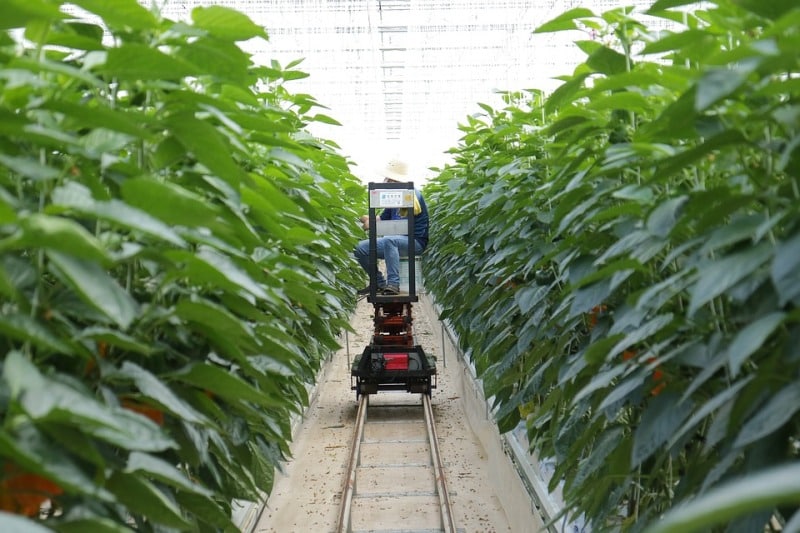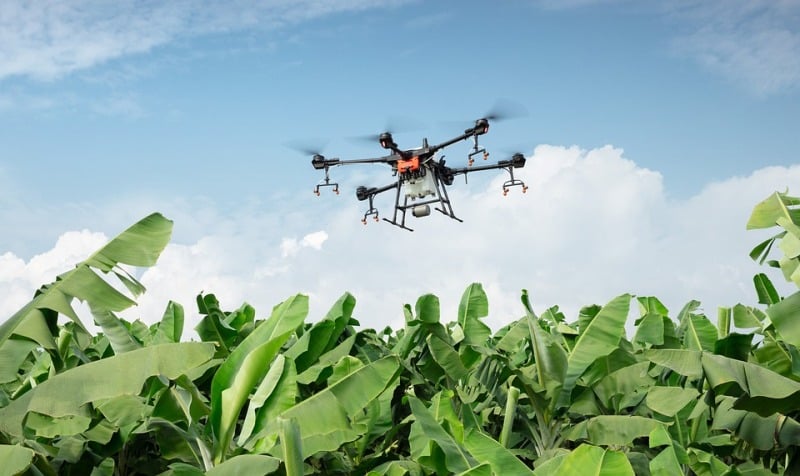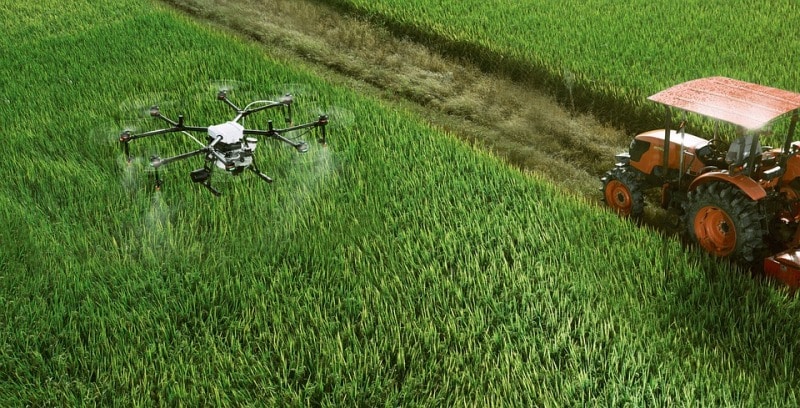Smart farming in India – A Step by Step Guide
Well, everybody is aware of India and its agriculture sector. There are many challenges and advantages in implementing smart farming techniques. So, farmers are showing interest in these technologies. India will definitely benefit and can say smart farming in India is going to be the future of agriculture. So, what are you waiting for, let us dive into the techniques of smart agriculture?
What is Smart farming? Smart farming systems reduce waste, develop productivity and enable management of a greater number of resources through remote sensing. Smart farming also called or precision farming. It includes a range of technologies, including remote sensing, Internet of Things (IoT) devices, robotics, big data analytics, and artificial intelligence, to form an integrated crop production management system on a site-specific basis to increase profits, reduce waste, and keep the environmental quality.

Read: Watermelon Farming Profits, Yield Per Acre.
Smart farming provides the agricultural/farming industry with the advanced information that including big data, the cloud and the internet of things (IoT) for tracking, monitoring, automating and analyzing operations in commercial agriculture sectors. Also called as precision agriculture, smart farming is software-managed and sensor-monitored. Smart farming is important due to the grouping of the expanding global population, the increasing demand for advanced crop yield, the need to use natural resources efficiently, the growing use and sophistication of information and communication knowledge and the increasing need for climate-smart agriculture.
Smart farming is key for the future of the agricultural industry:
Smart farming is a farming management theory using modern technology to increase the quantity and quality of agricultural products. Farmers in the 21st century have access to GPS, soil scanning, data management, and IoT technologies. By precisely measuring variations within a field and adapting the strategy thus, farmers can greatly increase the effectiveness of pesticides and fertilizers and use them more selectively. Similarly, using Smart farming techniques, farmers can improve monitors the needs of individual animals and adjusts their nutrition correspondingly, thereby preventing disease and enhancing herd health.
What do you need for Smart Farming? Knowledge and capital are necessary for any innovation. New farming technologies need more and more professional skills. A farmer is not only a person with a passion for agriculture, he or she is also a legal expert (to find their way during a growing maze of regulations) and a part-time data analyst, economist and accountant (making a living from selling agricultural create requires bookkeeping skills and an in-depth knowledge of market chains and price volatility).

Additionally, Smart Farming requires capital. Thankfully, there is a wide range of options obtainable. From using low capital investment smartphone applications that track livestock to a capital-intensive automated combine. In principle, implementing Smart farming technologies can be simply upscaled.
Read: How to Grow Vegetables in the Balcony.
A smart farming technology represents the function of modern Information and Communication Technologies (ICT) into agriculture, leading to what can be called a Third Green Revolution.
Smart farming helps reduce overall costs and improve the quality and quantity of products, Increasing control over production leads to improved cost management and waste reduction. The ability to trace anomalies in crop growth or livestock health, for example, helps eliminate the risk of losing yields. Also, automation boosts efficiency. With smart devices, multiple processes can be activated at the same instance, and automated services enhance product quality and volume by better controlling production processes.
Plant breeding and genetics revolutions, this Third Green Revolution is taking over the agricultural world based upon the combined application of Information and communications technology (ICT) solutions such as precision equipment, the Internet of Things (IoT), sensors and actuators, geo-positioning systems, Big Data, Unmanned Aerial Vehicles (UAVs, drones), robotics, etc. Smart Farming has a real potential to distribute an extra productive and sustainable agricultural making, based on a more precise and resource-efficient approach.
Benefits of smart farming:
The benefits of smart farming are given below;
Smart farming systems also enable careful management of the demand forecast and release of goods to market just in time to reduce waste. Smart farming is focused on the organization the supply of land and, concentrating on the right growing parameters and for example, moisture, fertilizer or material content to give production for the right crop that is in demand. The types of smart farming systems implemented depend on the use of software for the management of the business. Control systems manage sensor input, delivering remote information for supply and decision maintain, in addition to the automation of machines and equipment for responding to emerging issues and production support.
Cost management and waste decrease thanks to the increased control over production. Being able to see any anomalies in the crop growth or livestock health, you will be able to mitigate the risks of losing yield.
Increased business efficiency through development automation. By using smart devices, you can automate multiple processes across the production cycle, e.g. irrigation, fertilizing, or pest control.
Improved product quality and volumes. Achieve better control over the production practice and maintain higher standards of crop quality and growth capacity through automation.

Read: How to Keep Farm Records.
High crop productivity: the use of better and improved technologies in farming following the adoption of smart farming guarantee better productivity since the focus is on maximizing inputs and reducing wastage.
The decrease in the use of pesticides, fertilizers, and water: Traditionally, farmers applied water, fertilizers, and pesticides even without determining where such elements are required on the farm. However, with smart, apply water and other chemicals whenever and wherever they are needed and in the right quantities. Reduced utilize of these chemicals leads to low food prices, as the cost of farming goes down.
Reduce strain on the environment: Nowadays, smart farming has introduced improved approaches to increasing productivity while at the same time minimizing the wastage of chemicals, water, and other elements useful on the farm. The proposition is that you do not have to expose the environment with unnecessary harmful chemicals when you can use them sparingly and where they are highly needed.
Smart farming interconnected technologies:
Smart farming in India is strongly related to three interconnected technologies. They are;
Management Information Systems: Planned systems for collecting, processing, storing, and disseminating information in the form needed to carry out a farm’s operations and functions.
Precision Agriculture: Management of spatial and temporal variability to develop economic returns following the use of inputs and reduce environmental impact. It includes Decision Support Systems (DSS) for entire farm management with the goal of optimizing returns on inputs while preserving resources, enabled by the widespread use of GPS, aerial images by drones and the latest generation of hyperspectral images provided by Sentinel satellites, allowing the creation of maps of the spatial variability of as several variables as can be measured (for example, crop yield, terrain features or topography, organic matter content, moisture levels, nitrogen levels, etc).
Agricultural automation and robotics: In the smart farming the developments of applying robotics, automatic manage at all levels of agricultural production, including farm bots and farm drones.
Smart farming in India can also give great advantages in terms of environmental issues, through more efficient use of water, or optimization of treatments and inputs.
Smart farming technologies:
The Smart farm includes the use of technology such as:
- Sensors for soil scanning and water, light, humidity and temperature organization.
- Telecommunications technologies such as advanced networking and GPS.
- Hardware and software for specialized applications and for enabling the Internet of Things (IoT)-based solutions, robotics, and automation.
- Data analytics tools for decision making and prediction. Data collection is a very important element of smart farming as the quantity of data available from crop yields, soil-mapping, climate change, weather data, fertilizer applications, machinery, and animal health continues to escalate.
- Satellites and drones for gathering data around the clock for a total field. This information is forwarded to IT systems for tracking and analysis to provide an “eye in the field” or “eye in the barn” that makes remote monitoring possible.
Among the technologies obtainable for present-day farmers there are;
- Sensing technologies, for example, soil scanning, water, light, humidity, temperature management;
- Software applications specialized software solutions that target specific smart farm types;
- Communication technologies, such as cellular communication;
- Positioning technologies, including GPS;
- Hardware and software systems that enable IoT-based solutions, robotics and automation;
- Data analytics, that underlies the decision making and prediction processes.
Read: Agriculture Rural Development Challenges.
IoT-Based Smart Farming:
The IoT-Based Smart Farming Cycle (Internet of Things);
The core of the Internet of Things (IoT) is the data you can draw from things (“T”) and transmit over the Internet (“I”). To optimize the farming procedure, IoT devices installed on a farm must collect and process data in a repetitive cycle that enables farmers to react quickly to emerging issues and changes in ambient conditions. Smart farming follows a cycle like this one:
- Observation
Sensors record observational data from the crops, livestock, soil, and atmosphere.
- Diagnostics
The sensor values are fed to a cloud-hosted Internet of Things platform with predefined decision rules and models also called “business logic” and that ascertain the condition of the examined object and identify any deficiencies or needs.
- Decisions
After issues are revealed, the user, and/or machine learning-driven components of the IoT platform verify whether location-specific treatment is necessary and if so, which.
- Action
After the end-user estimate and action, the cycle repeats from the beginning.
Application Areas of Smart Farming:
The set of technologies used in smart farming is complex, to reproduce the complexity of activities run by farmers, growers, and other sector stakes- holders. For the smart farming is structured in the following seven application areas, they are;
- Fleet management – tracking of farm vehicles
- Arable farming, large and small field farming
- Livestock monitoring
- Indoor farming – greenhouses and stables
- Fish farming
- Forestry
- Storage monitoring – water tanks and fuel tanks
That’s all folks about smart farming in India, it’s challenges and advantages. Keep farming smartly!.
Read: How to Grow Spinach Hydroponically.
Thank you soo much for providing a rich and reliable source of knowledge to current and aspiring farmers.
Thank you so much for this information.